How ethnic visual culture influenced Chinese contemporary art
In the Western art historical canon, it is all too common to focus on the Euro-American influences that inspired and formed Chinese contemporary art during the beginning of the country’s transformative Reform and Opening-up policy, starting in the late 1970s. However, much less is known about domestic sources of inspiration, such as the influence that Chinese ethnic visual culture had on young artists during this time period. I would like to shed light on this important development by looking at the artist movement known as the Yunnan School of Painting, also known as Yunnan heavy-color painting, the Yunnan movement or the 云南画派 Yunnan Huapai (Yunnan Painting Movement) in Chinese.
Background and Context
The Yunnan School is one of the most important abstract movements in China but is much less known internationally than the movements of Cynical Realism or Political Pop (to find out more about Cynical Realism and what made Chinese art contemporary, read this article). It stands out as an early “homegrown” art style, formed by artists who either spent a considerable amount of time or were born in the Yunnan region.
Out of China’s 56 ethnic minorities, Yunnan is home to 27 different groups of minority peoples. It borders Myanmar, Laos, Vietnam as well as Tibet to the west and the Chinese provinces of Sichuan, Guizhou and Guangxi to the North and South East. With limited Western influence and such a rich diversity in different ethnic cultures, it was the immediate environment that gave the Yunnan School its unique character.
The Invention of the Yunnan School
Long before the invention of the Yunnan School and the development of Chinese contemporary art as we know it today, Yunnan has had a history as a source of exotic inspiration for artists from Central China, who fled to its remote mountainous regions in search of a safe haven during the last Sino-Japanese War and even as far back as ancient China, starting from the Ming Dynasty.
The Yunnan School started with a group of artists who met in Kunming in the early 1970s. These artists were art academics from different provinces, including Beijing graduates, 蒋铁峰 Jiang Tiefeng and 丁绍光 Ting Shao Kuang. Other important members of the group were 何能 He Neng, 何德光 He Deguang and 刘绍荟 Liu Shaohui, all of whom spent long periods of time (both voluntarily and involuntarily) in Yunnan during China’s Cultural Revolution. Similar to the exiled artists who fled the war in the early 20th century, this group of artists had ample time to penetrate deeply into the rich mix of ethnic cultures, customs, and folk arts abundant in Yunnan Province. When China opened up to the outside world in the late 1970s, the artists formed a movement out of this experience, which, for a brief period, put remote Yunnan at the forefront of China’s avant-garde.
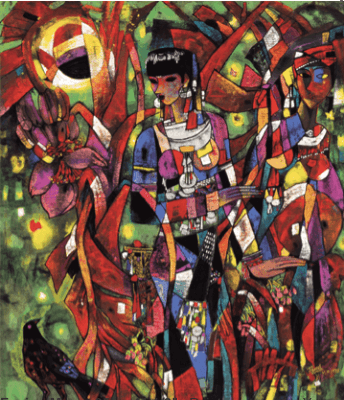
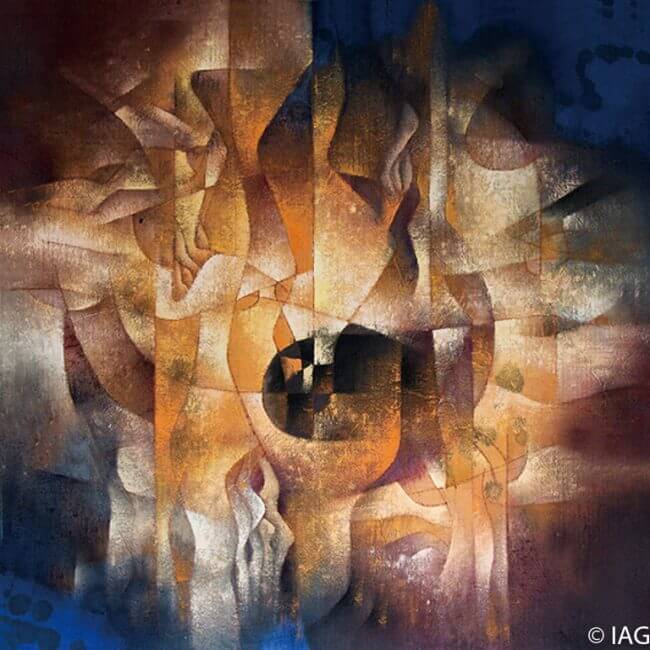
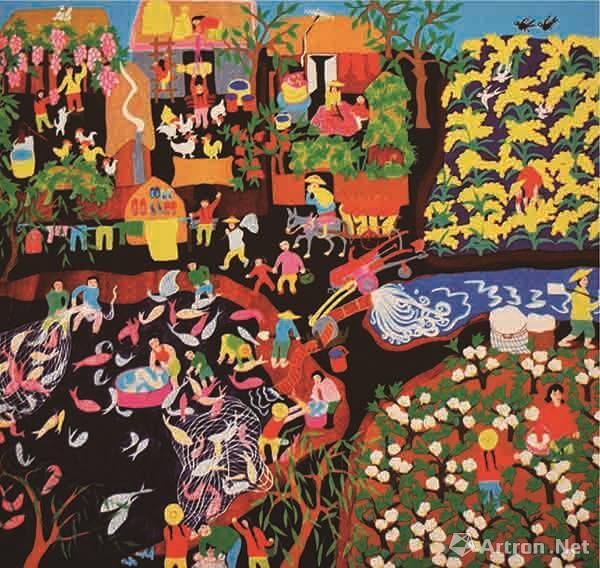
One of the most prominent Yunnan School founders was Ting Shao Kuang, who is often credited to have made the movement popular. He later continued his career successfully in the United States. To browse through some of his artworks, visit the following Pinterest board:
Another important founder is Jiang Tiefeng, who, after initially being criticised by Chinese authorities, was later commissioned by the government to paint a mural in the Great Hall of the People in Beijing in 1979. Like Ting Shao Kuang, he later moved to the U.S.
Other successful Yunnan School painters, apart from the above-mentioned founders, are 杨鹏 Yang Peng, 王玉辉 Wang Yuhui, 熊惠明 Xiong Huiming, 沈德坤 Shen Dekun, 吕敏 Lü Min and 叶松青 Ye Songqing. What needs to be noted is that the Yunnan School was mostly made up of Han-Chinese artists and not minorities themselves. Some of the few Yunnan School artists who did identify as minorities were Xiao Jiahe (a former student of Ting Shao Kuang’s), Su Jianghua and Yang Huangli.
For more Yunnan School artists, check this website or browse the below Pinterest board:
Style and Characteristics of the Yunnan School
The style of the Yunnan School emphasises the linear quality of objects by outlining them with thin black, gold, or silver lines. The flattened shapes are filled in with vibrant colors, using an ancient Chinese technique called 重彩 zhongcai (“heavy colors”). In the late 1970s, painters in Yunnan Province combined the heavy color method with motifs from ancient Buddhist cave paintings, and the flat, distorted figures found in Western cubism and fauvism, typically associated with Picasso, Miro and Matisse.
What was more, the paintings integrated imagery that had been shunned during the Cultural Revolution, such as Buddhist symbols, elements from Chinese mythology, as well as body paintings and tattoos used by some ethnic minorities. The patterns found on ethnic minority clothing also influenced the colors and imagery frequently seen in the Yunnan School paintings, as well as the tropical environment.
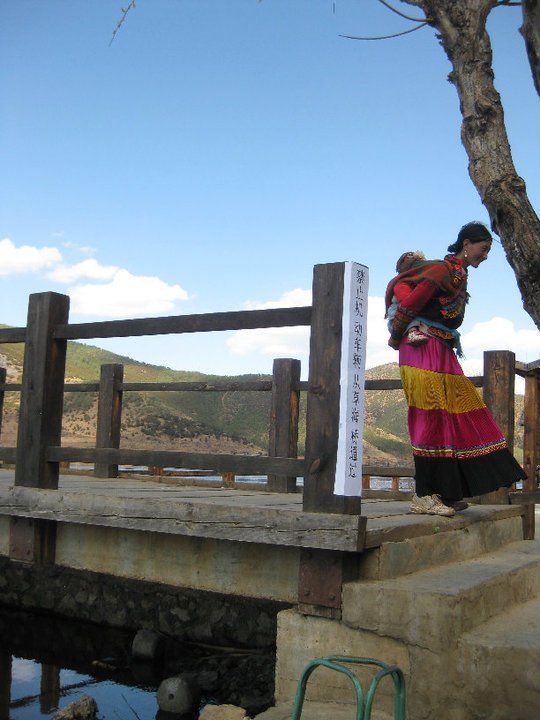

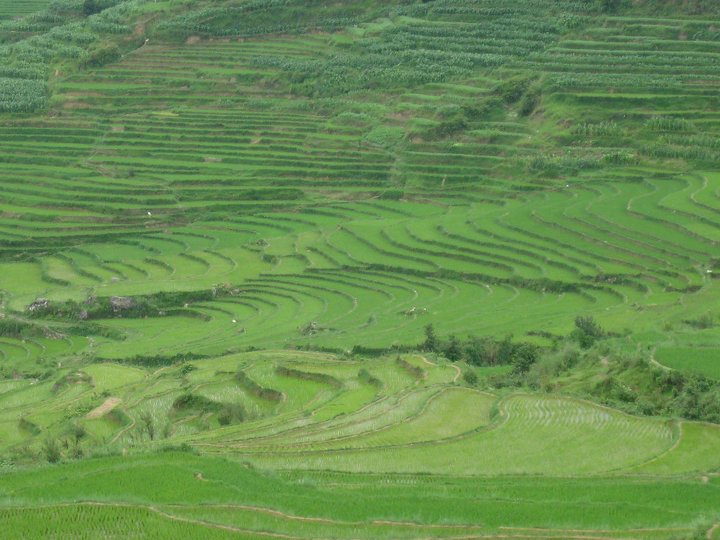
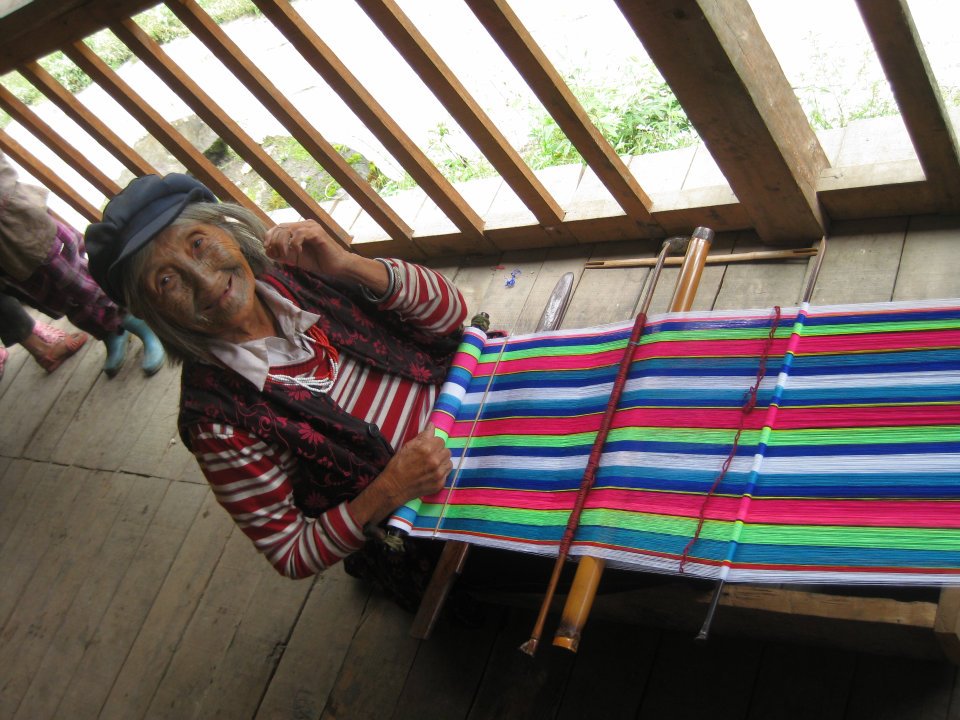
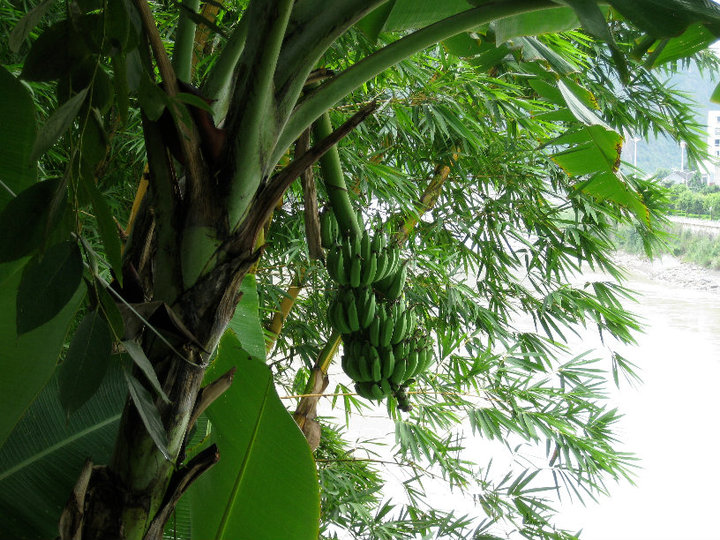
The integration of these elements produced a distinctive style that resembled neither traditional Chinese ink painting nor modern oil painting as it had ever been practiced before in China.
Furthermore, Yunnan School artists shocked China’s cultural authorities by frequently using erotic female imagery based on the customs and folklore of Yunnan’s ethnic minorities – although most depictions were kept very abstract, as can be seen in Jiang Tiefeng’s painting, Playing Water, below.
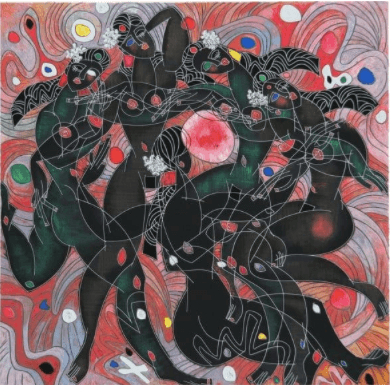
袁运生 Yuan Yunsheng, a Beijing-based painter sometimes associated with the Yunnan group, attracted the greatest attention with his nude figures in the Beijing airport murals. In 1981, Yuan’s mural was blocked off by officials who deemed the scarcely clad figures unfit for public display.

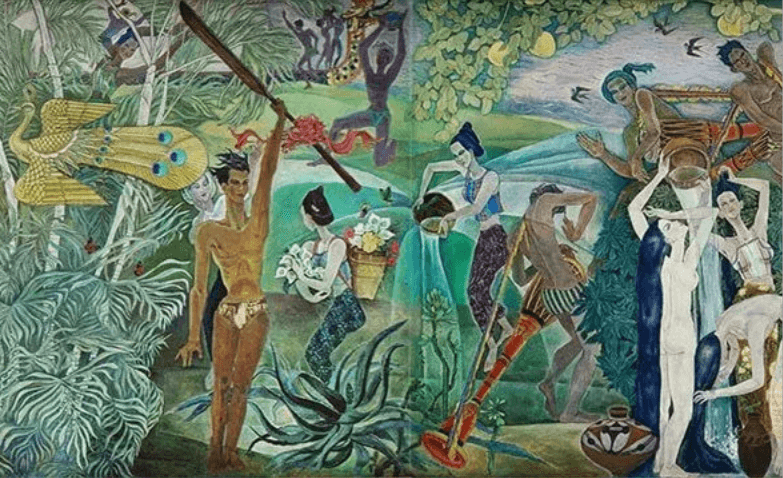
For more images of the mural, be sure to check the Joan Lebold Cohen Archive on the Asia Art Archive website and edspace.
Reception in the West
Paintings of the Yunnan School were very popular in the U.S. in the 1990s, with galleries such as Fingerhut Gallery’s owner Allan Fingerhut representing key figures such as Jiang Tiefeng for over 25 years. Although the style has been met with success, it has also received criticism in the West due to claims of objectifying and feminising depictions of indigenous peoples. This may have led to a declining interest in the style after its high in the 1990s. However, after more than 40 years since its invention, the Yunnan School still has an important influence on contemporary art in China today, and is, without a doubt, a phenomenon that is worth exploring in much greater depth.
Further Readings
If you find the artists mentioned in this article of interest, you can read through the digital exhibition catalogue of the six Yunnan School artists that were exhibited at Australia-China Institute for Arts and Culture Gallery from 2018-19 for more insight into the artists’ work here.
An interesting read about the Yunnan School and its history can be found in the following LA Times article.
If you would like to delve even deeper into the subject matter, try to get your hands on the following literature:
Lebold Cohen, Joan. Yunnan School: A Renaissance in Chinese Painting, Fingerhut Group Pub: 1988
Yoshino, Kosaku (ed.).”Painting Minorities: The Invention of the Yunnan School” by Dru C. Gladney in Consuming Ethnicity and Nationalism: Asian Experiences, University of Hawaii Press: 1999.
For more literature, make sure to browse these sites on the Conroy Wyman Galleries website.
Like our story about the Yunnan School Movement? Follow us on Facebook and Instagram.
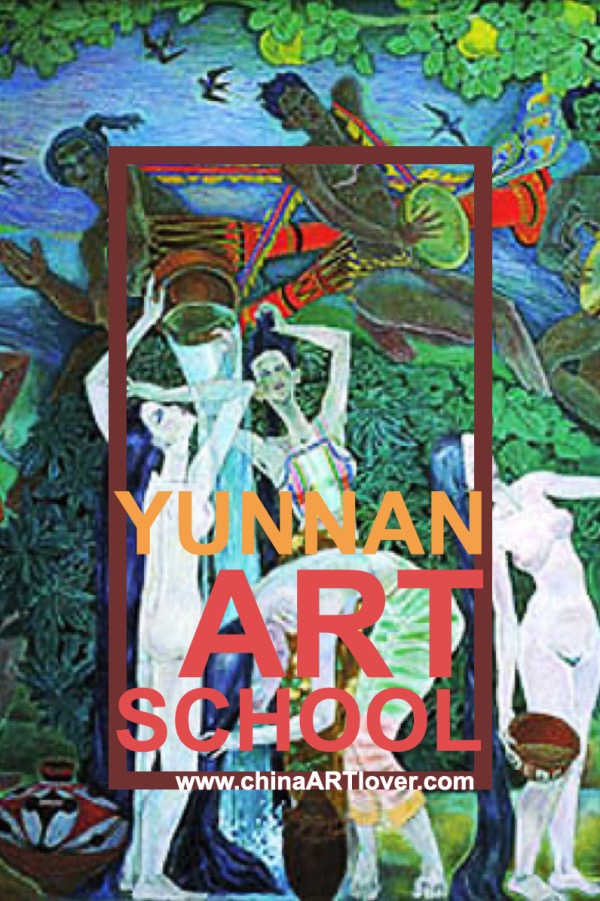

7 comments
Hey Cila. Didn’t know that Yunnan has been such an inspiration for you until my reading this article. I could somehow see you develop this to a doctoral dissertation though. Also, it still would be much possible to come to Yunnan for visiting if you don’t mind the two-week-quarantine though.
Thank you so much for your comment, Christopher. Indeed, Yunnan and the wonderful people I’ve met have been a huge inspiration to me! It could definitely be an interesting area of research. I might just go through two weeks of quarantine for that 😉
I also wanted to reply to your comment @Christian Since I was very happy that Cila showed me this particular art movement which I didnt know of. Unfortunately in my 5 years in China I never made it to Yunnan although I tried many times.. but work was always crazy and it didnt happen. So it is still on my bucket list… maybe you can show us around if you are still there? (btw. Yunnan cuisine is the best food in China in my opinon!)
Thanks pertaining to sharing this kind of wonderful subject matter on your site. I noticed it on the search engines. I will check back again whenever you post extra aricles. We love Google 🙂
You made some good points there. I did a search on the topic and hardly found any specific details on other sites, but then great to be here, seriously, thanks.
Thanks for sharing your thoughts. We are always happy to get positive feedback. Also please let us know if you are interested in other topics related to Chinese (contemporary) art. Maybe it is something we have some knowledge and can write a post about it. Take care and good to know you will come back to us on a regular basis. See you soon. 🙂
Once again, it is easy to see why this is one of the finest blogs on the entire Internet, keep pumping out the great content!
Comments are closed.